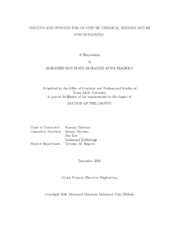| dc.contributor.advisor | Entesari, Kamran | |
| dc.creator | Elkholy, Mohamed Moustafa Mohamed Attia | |
| dc.date.accessioned | 2017-03-02T16:45:49Z | |
| dc.date.available | 2018-12-01T07:20:52Z | |
| dc.date.created | 2016-12 | |
| dc.date.issued | 2016-11-29 | |
| dc.date.submitted | December 2016 | |
| dc.identifier.uri | https://hdl.handle.net/1969.1/158977 | |
| dc.description.abstract | Integrating RF bio-chemical sensors and RF duplexers helps to reduce cost and area in the current applications. Furthermore, new applications can exist based on the large scale integration of these crucial blocks. This dissertation addresses the integration of RF bio-chemical sensors and RF duplexers by proposing these initiatives.
A low power integrated LC-oscillator-based broadband dielectric spectroscopy (BDS) system is presented. The real relative permittivity ε’r is measured as a shift in the oscillator frequency using an on-chip frequency-to-digital converter (FDC). The imaginary relative permittivity ε”r increases the losses of the oscillator tank which mandates a higher dc biasing current to preserve the same oscillation amplitude. An amplitude-locked loop (ALL) is used to fix the amplitude and linearize the relation between the oscillator bias current and ε”r. The proposed BDS system employs a sensing oscillator and a reference oscillator where correlated double sampling (CDS) is used to mitigate the impact of flicker noise, temperature variations and frequency drifts. A prototype is implemented in 0.18 µm CMOS process with total chip area of 6.24 mm^2 to operate in 1-6 GHz range using three dual bands LC oscillators. The achieved standard deviation in the air is 2.1 ppm for frequency reading and 110 ppm for current reading.
A tunable integrated electrical balanced duplexer (EBD) is presented as a compact alternative to multiple bulky SAW and BAW duplexers in 3G/4G cellular transceivers. A balancing network creates a replica of the transmitter signal for cancellation at the input of a single-ended low noise amplifier (LNA) to isolate the receive path from the transmitter. The proposed passive EBD is based on a cross-connected transformer topology without the need of any extra balun at the antenna side. The duplexer achieves around 50 dB TX-RX isolation within 1.6-2.2 GHz range up to 22 dBm. The cascaded noise figure of the duplexer and LNA is 6.5 dB, and TX insertion loss (TXIL) of the duplexer is about 3.2 dB. The duplexer and LNA are implemented in 0.18 µm CMOS process and occupy an active area of 0.35 mm^2. | en |
| dc.format.mimetype | application/pdf | |
| dc.language.iso | en | |
| dc.subject | Chemical sensor | en |
| dc.subject | biochemical | en |
| dc.subject | complex permittivity | en |
| dc.subject | LC-DCO | en |
| dc.subject | oscillator-based sensor | en |
| dc.subject | duplexer | en |
| dc.subject | electric balance duplexer | en |
| dc.subject | 3G communications | en |
| dc.title | Circuits and Systems for On-Chip RF Chemical Sensors and RF FDD Duplexers | en |
| dc.type | Thesis | en |
| thesis.degree.department | Electrical and Computer Engineering | en |
| thesis.degree.discipline | Electrical Engineering | en |
| thesis.degree.grantor | Texas A & M University | en |
| thesis.degree.name | Doctor of Philosophy | en |
| thesis.degree.level | Doctoral | en |
| dc.contributor.committeeMember | Palermo, Samuel | |
| dc.contributor.committeeMember | Zou, Jun | |
| dc.contributor.committeeMember | El-Halwagi, Mahmoud | |
| dc.type.material | text | en |
| dc.date.updated | 2017-03-02T16:45:49Z | |
| local.embargo.terms | 2018-12-01 | |
| local.etdauthor.orcid | 0000-0003-1597-7183 | |


